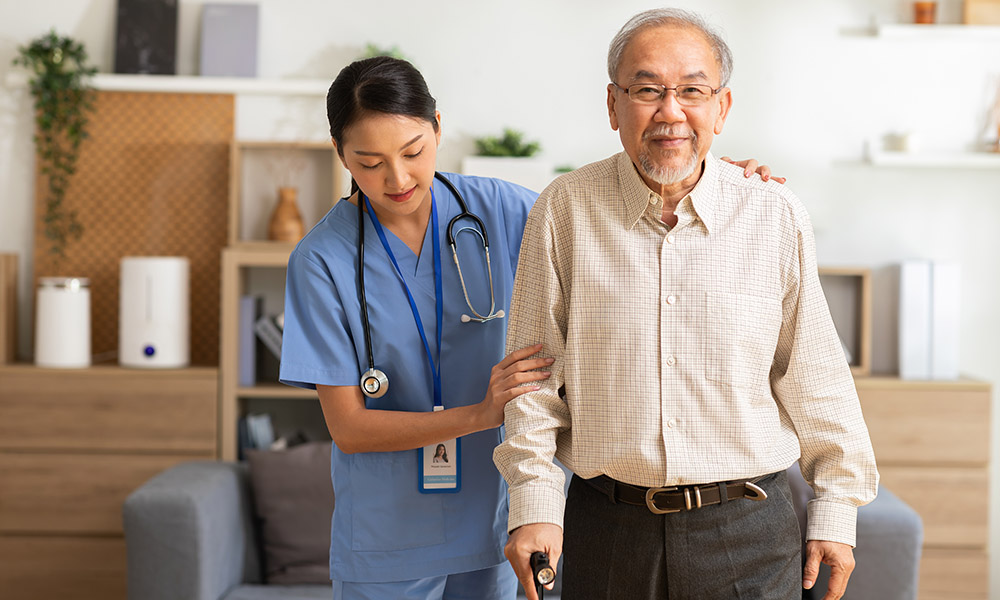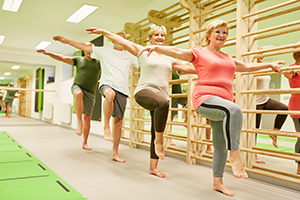June 29th, 2022
Fall Prevention

Fall prevention is an important topic for caregivers of elderly individuals. Falls are dangerous at any age, but older people are especially prone to injuries for a few reasons. As we age, our bones become less dense, which means a break is more likely to result from a fall. Reduced muscle strength and coordination, too, make it harder to recover from a loss of balance. And if an elderly person is injured from a fall, healing takes much longer than when in youth. That’s why falls are the most common cause of nursing home placement.
Many people who fall, even those who are not injured, develop a fear of falling that may cause them to limit their activities. This leads to reduced mobility and physical fitness, which actually increases their risk of falling.
If the person in your care has osteoporosis, they are more likely to break a bone if they fall. Osteoporosis is considered a silent disease because bones become weak with no symptoms. People often find out they have it when a strain, bump, fall, or even a cough causes a bone to break. Get the person in your care tested.
Why Do People Fall?
Falls and accidents seldom happen inexplicably. There are physiological reasons, as mentioned above, that may combine with other aging-related factors such as:
- Medications may cause dizziness.
- Diuretics (water pills) may cause urination urgency and walking too quickly to the bathroom.
- Vision decline, especially in people with dementia, can cause a misstep or other loss of balance.
- Cognitive impairment.
- Refusal or inconsistent use of walking aids like a cane.
- Alcohol consumption exacerbates existing issues of dizziness and slowed reaction time.
- Environmental reasons are equally to blame in many elderly falls.
- Throw rugs, clutter, electrical cords, and other household items pose tripping hazards.
- Uneven ground/flooring or needing to use stairs.
- Slippery surfaces in the bathroom.
- Using a stool or step ladder to reach items.
Preventing Falls
Regular exercise as well as regular eye and physical exams may help reduce the risk of falling by identifying deficits early on. People aged 65 and up should talk with their doctors about getting tested for osteoporosis and whether they are getting enough calcium and vitamin D (both of which reduce the chance of bone breakage if a fall should occur).
It’s important to thoroughly evaluate the living quarters to identify tripping hazards and other safety issues.
- Eliminate throw rugs and any loose items on the floor.
- Ensure common items are within easy reach (not requiring the use of a stool or step ladder). Avoid even a regular need to bend over to retrieve items from low storage, as that action can cause acute dizziness from the rapid change in blood pressure.
- Encourage older residents to always wear sturdy shoes; for those
- who want to wear house slippers or similar, be sure the bottoms have non-slip tread.
- Stairs should have railings on both sides.
- Install grab bars and anti-slip basin adhesives in the shower or tub. Any bathmats used in the bathroom need to be rubber backed.
- Use adequate nightlights along the route to the bathroom and/or keep a flashlight at the bedside to safely navigate at night. Bedside commodes may be a safer option for those with mobility issues.
What to Do If a Person Falls
How hard a person lands plays a major role in determining whether a person will break a bone. The greater the distance of the hip bone to the floor, the greater the risk of fracturing a hip; so, tall people have a higher risk of a fracture. The angle at which a person falls also is important. Falling sideways or straight down is riskier than falling backward onto the buttocks.
- A sudden fall can be startling and upsetting. Keep yourself and the person in your care as calm as possible. Take several deep breaths to try to relax.
- Keep them still on the floor or ground for a few moments. This will help you both recover from shock.
- Determine if there is an obvious injury. Getting up too quickly or in the wrong way could make an injury worse. If there is a serious injury, do not move the person; call for medical help.
- If no obvious injury is present, have the person roll onto their side. Rest for a few moments while their body and blood pressure adjust.
- Next, they should very slowly get up on hands and knees. Bring them a sturdy chair to use for balance. Have them place their hands on the chair seat and slide one foot forward so that it is flat on the floor. Keep the other leg bent so the knee is on the floor. From this kneeling position, they should slowly rise and turn the body to sit in the chair.
 Exercises to Improve Balance
Exercises to Improve Balance
Perform these exercises daily to strengthen muscles and improve balance.
- While holding the back of a sturdy chair or counter, stand on one leg at a time for a minute; slowly increase the time as you are able. Repeat with the opposite leg. If this exercise comes easy, then try to balance with your eyes closed and/or without holding on.
- Stand on your toes for a count of 10, and then rock back on your heels for a count of 10. Repeat three to five times, as you are able.
- Make a big circle to the left with your hips, and then to the right. Do not move your shoulders or feet. Repeat five times.
Source: National Institutes of Health
You might also like:
Assisting With Personal Hygiene >
Seniors and Hot-Weather Safety >
Challenges With Feeding Elderly Patients >

 Exercises to Improve Balance
Exercises to Improve Balance